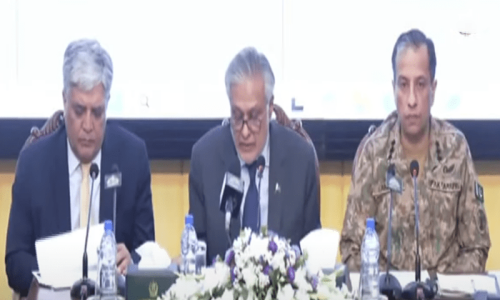ISLAMABAD: For the first time since nuclear tests by arch-rivals India and Pakistan in 1998, India has been reported by the Stockholm International Peace Research Institute (SIPRI) to possess more nuclear warheads than Pakistan, albeit by a slim margin of two warheads.
The report’s findings, released during the Eid holidays, come at a time of heightened concern over the escalating global reliance on nuclear weapons, fuelled by intensifying geopolitical tensions.
Historically, Western assessments, including those from SIPRI and the International Panel on Fissile Materials (IPFM), have shown Pakistan maintaining a slight lead over India in terms of nuclear arsenal size, generally by a margin of five to 10 weapons.
However, the latest assessments for 2023 have depicted a change, with India now marginally ahead.
SIPRI report reveals all nuclear powers are ‘modernising arsenals’, deploying new N-capable weapon systems
These assessments are primarily based on satellite imagery of uranium enrichment facilities and plutonium production plants. The operational history of these facilities provides critical data, yet the specifics of the methodologies and metrics used by SIPRI and IPFM remain largely undisclosed, raising questions about the precision of these estimates.
Both India and Pakistan maintain a high degree of opacity regarding their nuclear programmes, rarely commenting on or validating Western nuclear assessments. This lack of transparency makes it challenging to verify the accuracy of the reported figures.
It is claimed that Western estimates of South Asian nuclear capabilities are influenced by political motivations. This perspective is supported by the context of India’s broader nuclear programme and geopolitical posture. India, having tested its first nuclear device in 1974 and possessing a comprehensive nuclear triad, logically would not ever lag behind Pakistan—a country with a relatively younger nuclear programme.
India’s extensive air, ground, and sea-based nuclear delivery systems, along with one of the world’s largest indigenous uranium reserves, support a robust nuclear capability.
Further, the 2008 Nuclear Suppliers Group (NSG) waiver allowed India to import substantial amounts of nuclear fuel, thereby conserving its indigenous uranium for potential weapons development. This strategic advantage meant that current Western estimates underrepresented India’s actual nuclear capabilities.
According to the report, neither India nor Pakistan have nuclear weapons deployed at this time. However, India is reportedly shifting towards a strategy where some nuclear warheads are pre-attached to their launchers during peacetime.
Pakistani stockpile
As of January 2024, Pakistan, according to SIPRI estimates, maintained its nuclear arsenal at around 170 warheads, consistent with its previous year’s estimates. These warheads, as per the report, are distributed across Pakistan’s emerging nuclear triad, which includes aircraft, ground-launched ballistic and cruise missiles, and sea-launched cruise missiles.
Pakistan’s ongoing development of new delivery systems and the accumulation of fissile materials indicate potential growth in its nuclear capabilities over the next decade.
Pakistan’s military doctrine does not adhere to a no-first-use (NFU) policy, reserving the right to pre-emptive nuclear strikes, particularly due to perceived conventional force imbalances with India. This stance, SIPRI report noted, is emphasised by its focus on non-strategic nuclear weapons as a counter to India’s ‘Cold Start’ doctrine, which involves rapid military mobilisation.
The air-delivered component of Pakistan’s nuclear force, the report said, includes a small stockpile of nuclear gravity bombs and developing cruise missiles like the Ra’ad (Hatf-8), which enhances the nuclear stand-off capability of PAF at ranges between 350 and 600 km. Combat aircraft such as the Mirage-III, Mirage-V, F-16, and JF-17 are considered potential nuclear-delivery platforms, though their exact roles remain unconfirmed.
Pakistan’s land-based nuclear arsenal, it said, includes an estimated 126 short- and medium-range missile systems. This arsenal features several operational missile types, including the solid-fuelled Shaheen series and the liquid-fuelled Ghauri missiles. The Shaheen-III, a longer-range missile still in development, has been tested but is not yet deployed. Additionally, Pakistan is exploring MIRV technology with the developmental Ababeel missile, likely in response to India’s advanced missile defences.
For its sea-based nuclear capabilities, Pakistan is said to be developing the Babur-3 submarine-launched cruise missile (SLCM), aimed at equipping its Agosta-90B submarines, thereby advancing its second-strike capabilities. Military analysts claim Pakistan does not yet have a submarine platform to use nuclear weapons and clearly lags behind India in possessing assured second-strike capability.
A separate report by International Campaign to Abolish Nuclear Weapons (ICAN), citing a 2016 parliamentary report, claimed that Pakistan spends about 10pc of its total military spending on its nuclear arsenal. It estimated that Pakistan spent about $1bn in 2023 on its nuclear programme, which equals to an expenditure of $1,924 per minute.
Indian inventory
Indian nuclear arsenal as of January 2024, according to SIPRI, comprises approximately 172 nuclear weapons, showing a minor increase from the previous year.
These weapons are part of India’s developing nuclear triad, which includes aircraft, land-based missiles, and nuclear-powered ballistic missile submarines (SSBNs). Traditionally, India has kept nuclear warheads and launchers separate during peacetime, but recent actions suggest a shift towards mating some warheads with launchers in peacetime.
India’s nuclear strategy primarily aims to deter Pakistan and China. Initially, India’s shorter-range nuclear weapons targeted Pakistan, but with the development of longer-range missiles, China has also become a focus. India maintains an NFU policy, established in 1999, with modifications in 2003 that include potential nuclear responses to non-nuclear attacks.
India’s airborne nuclear capability includes aircraft like the Mirage 2000H, Jaguar IS, and Rafale, with about 48 nuclear gravity bombs assigned to these platforms. The land-based missile arsenal includes several types of ballistic missiles, with newer models like the Agni-P nearing deployment. The sea-based leg of the triad is expanding with four to six SSBNs planned, enhancing India’s second-strike capabilities. India has achieved intercontinental ranges and with upcoming Agni-VI and Surya missiles it will be able to target any country in the world.
Overall, India is increasing the readiness of its nuclear forces and may be shifting towards a counterforce posture, which aims at targeting an adversary’s nuclear arsenal pre-emptively.
ICAN’s report estimated that India spent $2.7bn on nuclear programme in 2023, which equalled an expenditure of $5,057 per minute.
Global context
The report revealed that all nine nuclear-armed countries, the US, Russia, the UK, France, China, India, Pakistan, North Korea and Israel, are modernising their arsenals and deploying new nuclear-capable weapon systems.
Globally, the total number of nuclear warheads is estimated at 12,121, with 9,585 of these in military stockpiles ready for potential use. About 2,100 warheads are maintained in a state of high operational alert on ballistic missiles, primarily by Russia and the US, with China recently joining this high-alert grouping.
The report underscores the persistent modernization efforts by nuclear states, which not only include upgrades to existing arsenals but also the development of new technologies such as multiple independently targetable re-entry vehicles. This capability, pursued by India, Pakistan, and North Korea, could lead to a rapid increase in the number of deployable warheads and the potential for more widespread destruction in conflict scenarios.
Published in Dawn, June 20th, 2024













































